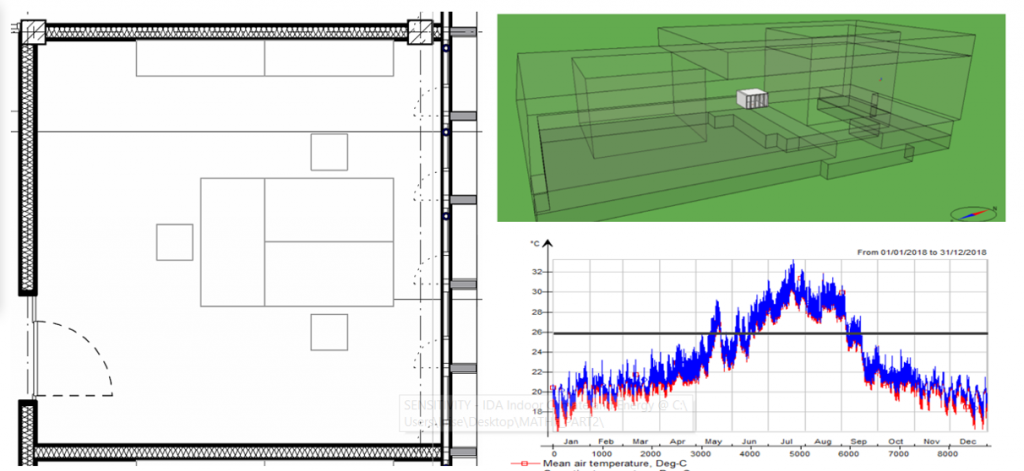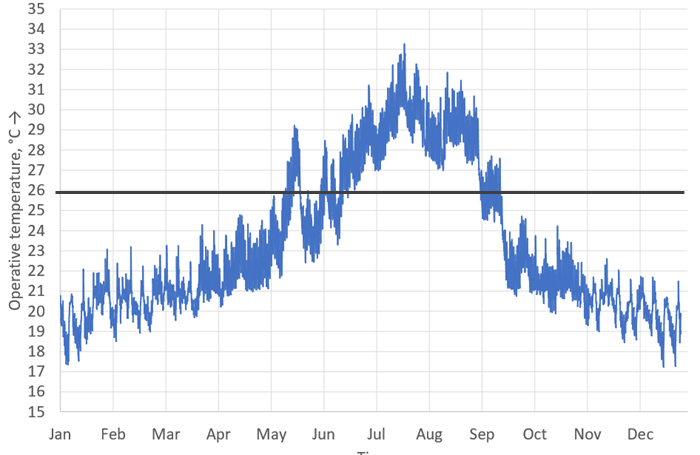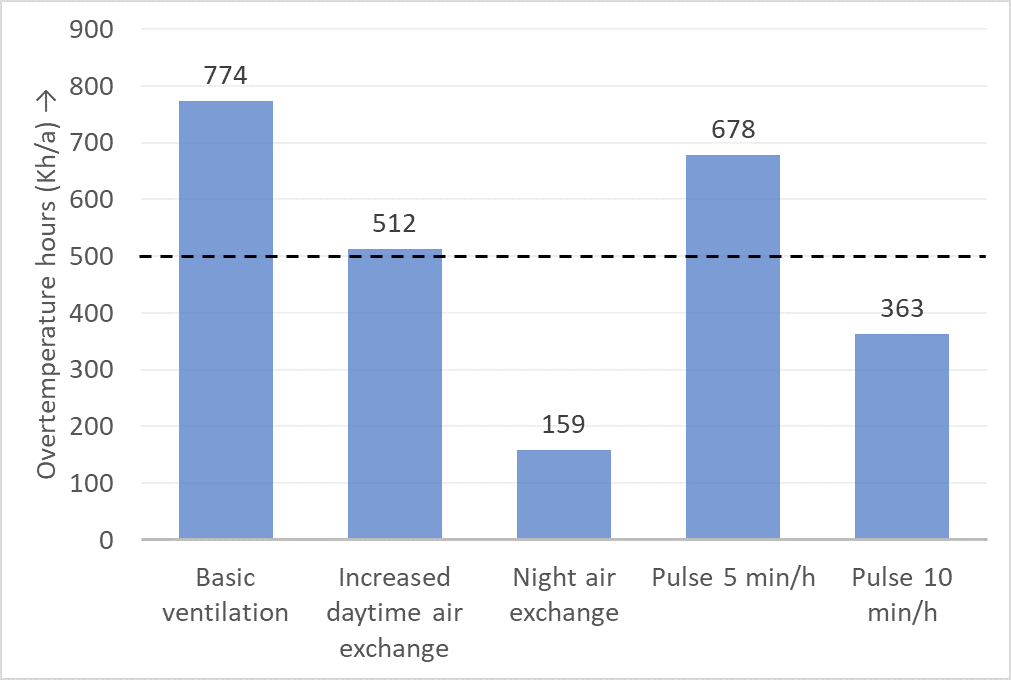
Facing increasing outdoor tempertures in the upcoming years due to global warming, the consideration and quantification of indoor quality needs to be more emphasized, especially with regard to good working conditions. Increasing over temperature hours (OTH) in office and education buildings will cause an increasing stress for employees.
In this context, the summer heat protection verification method described in the DIN 4108-2 is being evaluated by the HCBC team. This method allows the planers to predict the thermal behavior of critical areas and concludes if the area is well designed concerning the quality of thermal conditions. This evaluation shall develop reliable suggestions to enhance the actual verification methods and to lead to more ambitious requirements and thereby to better indoor conditions. In section 8.4, the norm defines the procedure to conduct the building simulation and the analysis of the results. The intention of this work is to find areas of improvement and expand the scope of the methodology.
In the DIN 4108-2, the „Overtemperature hours“ (OTH) are defined as the main indicator to conduct the analysis. This is an integration of the time (in hours) in which the indoor temperature is above a reference value (Ɵ °C) and it is represented in Kh/a. The permissible OTH’s are given accordingly to the usage of the building: 1200 Kh/a for residential buildings and 500 Kh/a for non-residential buildings. The norm divides Germany into three different climate regions, each with a different reference value.
A critical room in the new MATHE building was selected as a base case in the study. This room is planned as an office for 3 people, has a total area of 26 m2 and is oriented to the southeast. The room is in a non-residential building and within the climate region B. Hence, the reference value (Ɵ) is 26°C and it is expected to have less than 500 Kh/a.
In this study, IDA ICE is used as simulation software. The room model was based on the planning documents and the construction properties stated in the EnEV. The simulation was conducted according to the DIN 4108-2, section 8.4 with basic ventilation. The results of this simulation show that due to its orientation as well as the expected operation, this room achieves temperatures above 30°C during the summer and its total OTH’s are above 700 Kh/a. Therefore, it does not meet the requirements.

The standard mentions other ventilation techniques such as: Increased air exchange during the daytime and night air exchange. The first one refers to an increased air exchange during occupancy hours when the indoor temperature is above 23°C and, at the same time, above the outdoor temperature. The second refers to the possibility of additionally keeping the windows open during the night (23:00 to 6:00) and defines it as a constant value. As a result, a decrease in the OTH’s is observed. In the first case they are reduced by 34% but still above the limit value. In the second case, a value of 159 Kh/a is achieved, thus validating the room according to the standard and approving the design and operation. The results are shown in the next graph.

After studying the results in detail, three main points of criticism were found, the first point is the ability to ensure air exchange without the use of mechanical ventilation, which is limited by factors such as noise from the surroundings. The second point is the simplification of the system. There are standards such as DIN V 18599 in which more detailed models of different thermal zones are defined. The internal gains, occupancy times and minimum ventilation values depend on the type of use of the zones. The third point is the use of only one indicator and the lack of important information in the design assessment.
To address the first point, more ventilation methods are studied. Among those, pulsed ventilation was implemented, also shown in the graph. This type of ventilation consists in opening the windows during small time intervals, allowing fresh air flow. In this case, two different scenarios were studied. In the first one, the opening of the windows for 5 minutes every hour during the occupation time; in the second one, the interval was increased to 10 minutes per hour. The results show a better behavior in both cases, but only in the scenario with 10 minutes per hour the OTH’s are bellow the limit value with 363 Kh/a. Additional ventilation strategies, included mechanical ventilation and more realistic human interaction, are to be evaluated to create a bigger understanding in this area.
For the second point, additional simulations are studied to understand the impact of the simplification of the critical room. Following other norms such as DIN V 18599 will show the benefits of a more detailed study. Finally, for the third point, more indicators are needed to ensure the comfort of the critical rooms during summertime. It is intended to optimize not only the OTH’s but also the maximum indoor temperature, the air quality, noise from the surroundings, among other factors.
NEWSLETTER ABONNIEREN
Um über Neuigkeiten auf dem Blog informiert zu werden, können Sie sich hier mit Ihrer E-Mail-Adresse für den Newsfeed registrieren. Sie werden dann per E-Mail benachrichtigt, wenn neue Newseinträge veröffentlicht werden.
